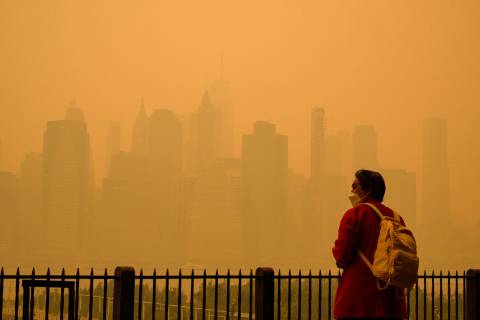UPDATE: Jun. 28, 2023, 12:06 p.m. EDT Smoke from Canadian wildfires is again impacting air quality in the United States weeks after initial warnings, as Midwest cities are alerted to monitor conditions and take precautions. Major cities in the Northeast also have been advised to keep an eye on their local air quality index and prepare to protect themselves, as smoke is expected to affect parts of the region this week.

As Americans throughout the Northeast peer out their windows to what some are comparing to a dystopian haze, soundtracked by special weather phone alerts warning of alarmingly poor air quality, life seemingly goes on.
It's the latest of the escalating natural disasters that trail in the wake of our growing climate crisis, including the now-expected wildfire seasons of America's West Coast and the abysmal air quality realities in countries around the world. According to World Health Organization (WHO) data from 2022, 99 percent of the global population breathes air that exceeds the organization's air quality limits and threatens individuals' health.
While these communities have been forced to reenvision this status as their new normal, the traveling wildfire smoke from Canada might feel apocalyptic for those experiencing such a crisis for the first time. It's a prescient wake-up call and cry for action.
But despite the smoke anticipated to continue clouding the region, potentially through the rest of the week, residents wondering how to protect themselves can be reassured that taking fairly simple precautions can help them push through to clearer skies, less discomfort, and reduced health risks.
I think my bottom line would be to be smart. Don't do things you don't need to do, don't exercise outside, don't remain for long periods of time outside, said Dr. Barbara Mann, pulmonologist at Mount Sinai-National Jewish Health Respiratory Institute and assistant professor of medicine at the Icahn School of Medicine at Mount Sinai. But, you know, if you need to go get groceries or get to your job, that's fine, and you can wear an N95 mask to minimize your exposure.
SEE ALSO: Feeling an existential crisis brewing? Here are 3 ways to cope.Who is most vulnerable?
While the very young, the very old, pregnant women, and people with respiratory issues or cardiovascular issues are most at risk of adverse health effects related to the smoke, Mann said all populations should avoid prolonged exposure.
According to the United States Environmental Protection Agency (EPA), fine particles in smoke can cause health problems ranging from burning eyes and runny nose, to illnesses such as bronchitis and aggravation of conditions like chronic heart and lung diseases. N95 masks can help filter out some of those particles, Mann said, while other face coverings like cloth masks, surgical masks, or wet handkerchiefs won't be very effective.
The Centers for Disease Control and Prevention (CDC) also notes that individuals living in areas of lower socioeconomic status and outdoor workers are among those who may be at increased risk of experiencing health effects from exposure to wildfire smoke. Potential effects of breathing in smoke listed by the CDC include headaches, wheezing, chest pain, and asthma attacks. The organization has specific guidance on its website for people with various risk factors.
For populations at higher risk of respiratory attacks, the American Lung Association recommends reviewing (or creating) your asthma action plan and COPD action plan for post-wildfire symptom monitoring. If problems develop, call your physician immediately.
How should I protect myself?
Having N95 masks on hand and keeping an eye on the air quality index will continue to be helpful even after this smoke clears, according to Mann, who recommended the U.S. Air Quality Index site at AirNow.gov and the American Lung Association as valuable resources for up-to-date information.
And investing in a quality air purifier is a good idea, especially for those with health vulnerabilities, she said, as smoke can get indoors even with windows closed.
The Environmental Protection Agency (EPA) explains that smoke can enter a home through open windows and doors (known as natural ventilation); through devices like fans, vents, or HVAC systems (known as mechanical ventilation); or through small openings or cracks in your home (known as infiltration). Covering any cracks that allow air to enter the home with wet towels can help reduce exposure to large particles, according to Dr. Zachary Rubin, pediatric allergist and clinical immunologist, from his popular TikTok account. The EPA also has a guide to managing your indoor air quality.
If you happen to have an air purifier, definitely turn it on, let it run at full blast, and keep it in the room that you're in most of the time, Mann advised.
Mann noted that minimizing other contributors to poor indoor air quality, like smoking or vaping indoors, or burning candles or incense, are other ways to protect your respiratory and pulmonary health. The EPA also includes spraying aerosols, frying foods, using wood or gas stoves, and vacuuming without a HEPA filter as other ways that one could unknowingly increase fine particles in their home.
And keep in mind pets can be affected too, so keeping walks short to minimize exposure is best until the smoke clears, Mann said.
SEE ALSO: When will the Canada wildfire smoke clear? Not as soon as you'd like.Those close to the wildfires may need to take stronger precautions. According to the CDC's Wildfire Guide this may include:
Creating a clean room, with filtered air, at home.
Sheltering in a cleaner air shelter or cleaner air space if the indoor air quality at home cannot be kept sufficiently clean.
Wearing a fit-tested, NIOSH-approved N95 or P100 respirator (for individuals who must spend time outdoors).
Individuals at elevated risk of heat-related illnesses are also at risk of health effects from wildfire smoke exposure and should be advised to stay in air-conditioned places as much as possible, the organization writes.
Why are the wildfires so out of control?
Wildfires can be normal and healthy parts of an ecosystem, but today's fires can burn into unnatural infernos, producing unhealthy smoke that adversely impacts people's health hundreds of miles away. Different regions, at different times of year, will have a variety of influences stoking flames. Yet the continually warming atmosphere, which turns vegetation into profoundly parched fuel, is often a significant contributor in extreme fires, as are overgrown and mismanaged forests, invasive plants, and other factors.
SEE ALSO: Wildfire smoke maps: 4 best sites for tracking the smokeHotter temperatures and lack of rainfall increase the risk of drought and wildfires, both of which create particle pollution. Wildfires have become a major source of extremely high particle levels in places hundreds of miles from the fire itself. Dust storms may increase as soil dries out and the water table drops. Even with current measures to reduce particle pollution, these changes have led to increased high particle pollution days with worse levels of pollution in many places in the U.S, the American Lung Association explains.
From the direct impact of the temperature and weather changes to the special burdens these changes place on the most vulnerable communities, climate change seriously threatens our wellness — especially our lung health.
In the short term, according to Mann, most worried individuals on the East Coast should be aware of their own limits and proceed with a plan that includes a reasonable level of caution until the smoke clears. The basics are just staying inside as much as possible, only going outside for things that are really necessary...but also not panicking if you need to go outside to do something.
For more Social Good stories in your inbox, sign up for Mashable's Top Stories newsletter today.
